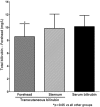Influence of assessment site in measuring transcutaneous bilirubin
- PMID: 24728239
- PMCID: PMC4898232
- DOI: 10.1590/s1679-45082014ao2711
Influence of assessment site in measuring transcutaneous bilirubin
Abstract
Objective: To investigate the influence of the site of measurement of transcutaneous bilirubin (forehead or sternum) in reproducibility of results as compared to plasma bilirubin.
Methods: A cohort study including 58 term newborns with no hemolytic disease. Transcutaneous measurements were performed on the forehead (halfway between the headline and the glabella, from the left toward the right side, making consecutive determinations, one-centimeter apart) and the sternum (five measurements, from the suprasternal notch to the xiphoid process with consecutive determinations, one-centimeter apart) using Bilicheck® (SpectRx Inc, Norcross, Georgia, USA). The correlation and agreement between both methods and plasma bilirubin were calculated.
Results: There was a strong linear correlation between both determinations of serum bilirubin at the forehead and sternum (r=0.704; p<0.01 and r=0.653; p<0.01, respectively). There was correspondence of the mean values of transcutaneous bilirubin measured on the sternum (9.9 ± 2.2mg/dL) compared to plasma levels (10.2 ± 1.7 mg/dL), but both differ from the values measured on the forehead (8.6 ± 2 .0mg/dL), p<0.05.
Conclusion: In newborn term infants with no hemolytic disease, measuring of transcutaneous bilirubin on the sternum had higher accuracy as compared to serum bilirubin measurement on the forehead.
Objetivo:: Verificar a influência do local da mensuração da bilirrubina transcutânea (fronte ou esterno) na reprodutibilidade dos resultados, quando comparada à bilirrubina plasmática.
Métodos:: Estudo tipo coorte incluindo 58 recém-nascidos a termo sem doença hemolítica. Foram realizadas determinações transcutâneas na fronte (a meia distância entre a raiz do couro cabeludo e a glabela, iniciando do lado esquerdo em direção ao direito, realizando determinações consecutivas, separadas por 1cm) e no esterno (cinco mensurações iniciando da fúrcula até o apêndice xifoide, com determinações consecutivas, separadas por 1cm), utilizando o equipamento Bilicheck® (SpectRx Inc, Norcross, Geórgia, Estados Unidos). Foram calculadas as correlações e a concordância entre ambos os métodos, e a bilirrubina plasmática.
Resultados:: Foi encontrada forte correlação linear tanto entre a determinação na fronte quanto no esterno, com nível sérico de bilirrubina (r=0,704; p<0,01 e r=0,653; p<0,01, respectivamente). Houve correspondência dos valores médios de bilirrubina transcutânea aferidos no esterno (9,9±2,2mg/dL) com os valores plasmáticos (10,2±1,7mg/dL), porém ambos diferiram dos valores medidos na fronte (8,6±2,0mg/dL), com p<0,05.
Conclusão:: Em recém-nascidos a termo sem doença hemolítica, a mensuração da bilirrubina transcutânea realizada no esterno apresenta maior acurácia em relação à mensuração na fronte, quando comparada à bilirrubina sérica.
Conflict of interest statement
Conflict of interest: none.
Figures




References
-
- Keren R, Tremont K, Luan X, Cnaan A. Visual assessment of jaundice in term and late preterm infants. Arch Dis Child Fetal Neonatal Ed. 2009;94(5):F317–F322. - PubMed
-
- Ip S, Chung M, Kulig J, O'Brien R, Sege R, Glicken S, et al. American Academy of Pediatrics Subcommittee on Hyperbilirubinemia. An evidence-based review of important issues concerning neonatal hyperbilirubinemia. Pediatrics. 2004;114(1):e130–e153. - PubMed
-
- Facchini FP, Mezzacappa MA, Rosa IR, Mezzacappa F, Filho, Netto AA, Marba ST. Acompanhamento da icterícia neonatal em recém-nascidos de termo e prematuros tardios. J Pediatr (Rio J) 2007;83(4):313–318. - PubMed
-
- American Academy of Pediatrics Subcommittee on Hyperbilirubinemia Management of hyperbilirubinemia in the newborn infant 35 or more weeks of gestation. Pediatrics. 2004;114(1):297–316. - PubMed
-
- Facchini FP. Avaliação da variabilidade da dosagem transcutânea de bilirrubina pelo Bilicheck em neonatos. Rev Paul Pediatria. 2006;24(2):149–154.
Publication types
MeSH terms
Substances
LinkOut - more resources
Full Text Sources
Other Literature Sources

